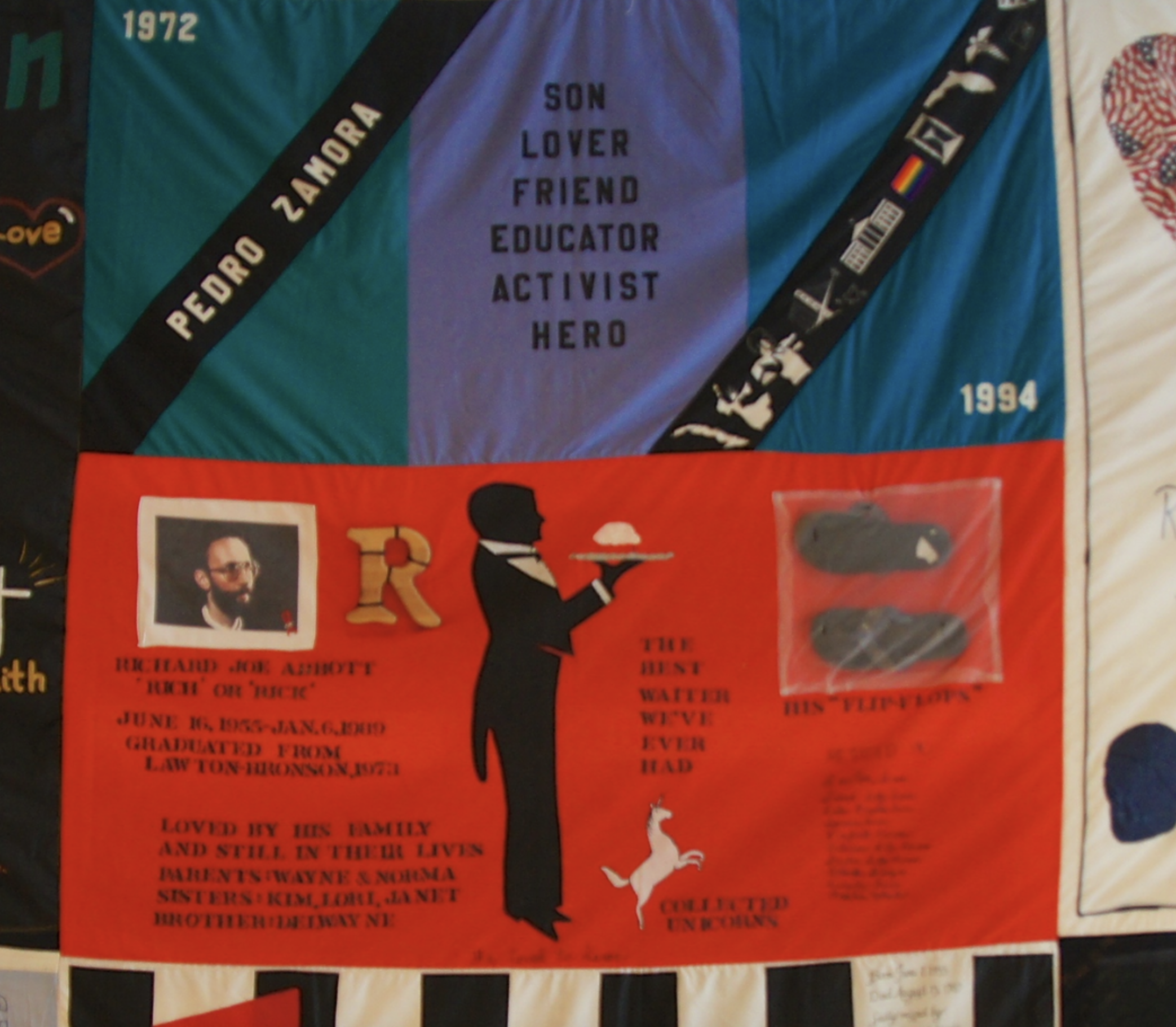Pedro Zamora from MTV’s Real World & Radical Death Activism
Justin Cook, PhD | December 28, 2019
Pedro Zamora was so much more than just one of the stars of the 1993 season of MTV’s The Real World. He was, as his AIDS Quilt patch made very clear – a son, lover, friend, educator, activist, and hero. He was also one of the first openly gay people with HIV to appear on television. But even before his time on The Real World, Zamora was an HIV/AIDS advocate having been involved with the Miami HIV/AIDS organization Body Positive and lectured at schools throughout the country working towards comprehensive sexual education programs inclusive of safe sex practices and HIV/AIDS awareness.
Pedro Zamora’s patch on the AIDS Quilt. There are two stripes of teal with a stripe of purple in the middle. The image reads: “Pedro Zamora, son, lover, friend, educator, activist, hero. 1972-1994” Source: “2012 AIDS Quilt DC 13799 - Pedro Zamora, from MTV's Real World - 22 years old” by Ted Eytan. Image licensed under CC BY-SA 2.0.
After his time on The Real World, Pedro delivered the following testimony to the United States Congress: “There is not one second of my day that I am not aware that I am HIV-positive. I don’t want to forget that I have AIDS, and I don’t want you to forget that I have AIDS. You have to understand AIDS is part of my life. It’s my reality. It’s who I am.”
Pedro wore his HIV status on his sleeve, a tactic that Robert Gutierrez-Perez names as that of the nepantleras or “queer people of color interlocutors that trouble rigid categories of identity” (345). Because of the tensions, threats, and assaults he faced on the show, Zamora was constantly putting his body at risk in order to perform this nepantleras work. In doing so, “Zamora mediated the borderlands between the known and the unknown to educate the public on the realities of living with HIV in everyday life” (346) in a time when HIV/AIDS was still practically a death sentence, just a few short years before the azidothymidine, aka AZT or Retrovir, “ray of hope” for HIV/AIDS sufferers.
Jose Esteban Munoz heralds Zamora with having “enabled the possibility of queer and Latino counterpublics, spheres that stand in opposition to the racism and homophobia of the dominant public sphere” (143). In doing so alongside his HIV status, Pedro became not just an activist for life with HIV, but for facing death with dignity and courage. As I’ve written before, the discourse surrounding HIV/AIDS in the 1980s and 1990s was far from encouraging for the majority of those suffering from the diseases. Because of this, any activism on the part of HIV/AIDS became, by proxy, death activism.
Pedro’s reclaiming of the “confessional” or testimonial portion of The Real World: San Francisco became what Munoz (by way of Michel Foucault) calls an “ethics of the self” (Munoz 143). These “ethics of the self” are a “working on the self for others” (144). Pedro’s frank and educational confessionals became a vehicle by which he assuaged the fear of living with HIV/AIDS, of living with someone who had HIV/AIDS, and of dying from HIV/AIDS. He was consummately brave and attentive to the fears of his audience. Munoz continues that “The performance of Latina/o, queer, and other minoritarian ontologies—which is to say the theatricalization of such ethics of the self—conjures the possibility of social agency within a world bent on the negation of minoritarian subjectivities” (145-46).
These confessionals, while just one of Pedro’s many activisms, not only served to inform the MTV audience about the disease, but also to show a man living and dying from it with dignity and agency. Darian Aaron quotes Zamora as saying, "I'm a person living with AIDS and I'll be living with AIDS until I take my last breath" and that is exactly what he did. Pedro lived, taught us how to live, died, and taught us how to face death.
In a MTV special on Pedro’s life, then-President Bill Clinton claimed, “Over the past years, Pedro became a member of all of our families. Now no one in America can say they’ve never known someone who is living with AIDS” (1994). Pedro became one of the faces of the HIV/AIDS movement, but he also became a powerful voice for minority sexuality and death-acceptance.
Further still, in his pitch letter to be selected to MTV Real’s World (cited at length below) Zamora he expertly identified not only the need for HIV/AIDS awareness, but also played on the looming threat his presence would command on the show. He speaks of the quotidian acts of sharing communal spaces, suggests intimacy with non HIV+ housemates and strategically remains neutral (“Things that make you go hmmmm.”) about their impact so as to let MTV producers fill in the silence his words created. Whether he intended it or not, Pedro both used and subtly manipulated the conversation surrounding HIV/AIDS and the inherent specter of death to educate about and fight for reform.
“So why should I be on The Real World? Because in the real world there are people living productive lives who just happen to be HIV+. I think it is important for people my age to see a young person who looks and feels healthy, can party and have fun but at the same time needs to take five pills daily to stay healthy. On one of your episodes this season you had a HIV+ guy come in and talk about AIDS/HIV with the group. He was there a few hours and he left. I wonder what kind of issues would have come up if that HIV+ guy would be living with the group, sharing the bathroom, the refrigerator, the bedroom, eating together? Everyday for six months. Things that make you go hmmmm.”
Quoted directly from Pedo Zamora’s pitch letter to MTV Real World (qtd in Munoz 149-50)
Pedro Zamora (left) and a friend dressed in business attire and smiling. Source: “PedroZamora1993” by Callelinea at the English Wikipedia is licensed under CC BY-SA 3.0.
References
Gutierrez-Perez, Robert. “Monstrosity in Everyday Life: Nepantleras, Theories in the Flesh, and Transformational Politics.” The Popular Cultural Studies Journal, vol. 6, no. 2 (2018): 345-68.
Munoz, Jose Esteban. “Pedro Zamora’s Real World of Counterpublicity: Performing an Ethics of the Self.” In Disidentifications: Queers of Color and the Performance of Politics, 143-60. Minneapolis, University of Minnesota Press, 1999.
“A Tribute to Pedro Zamora.” The Real World, season 3, episode 23, directed by Robert Fisher Jr. and George Verschoor, MTV. Nov 17, 1994.
Additional Resources
For a timeline of HIV/AIDS, see the FDA’s HIV Timeline and History of Approvals
For more on the AIDS Memorial Quilt, see the NAMES Project Foundation’s website
For more on Pedro Zamora, see the following:
Pedro Zamora’s Legacy Hasn’t Dimmed 25 Years After His Death from The Advocate
Pedro Zamora interview from Inside “The Real World: San Francisco” from ETOnline
About the Author
Dr. Justin Cook is Assistant Professor and Writing Center Director at High Point University. His work focuses on the rhetorical capacity of dead and decaying bodies as well as fringe rhetorical theories that challenge the current conception of his field. Previous publications and presentations have focused on death as a theme in the composition classroom, the obituary as a personal narrative, and multimodal pedagogical implementation techniques in the composition classroom.


